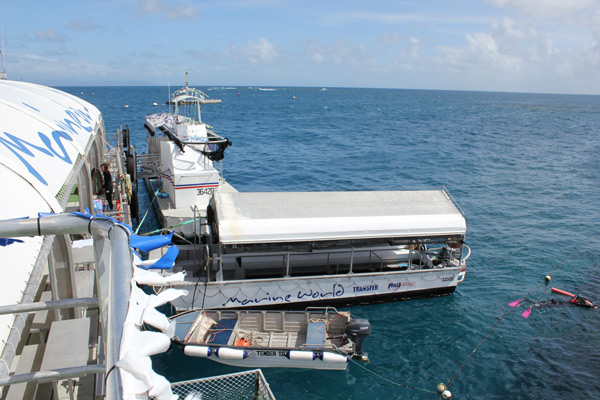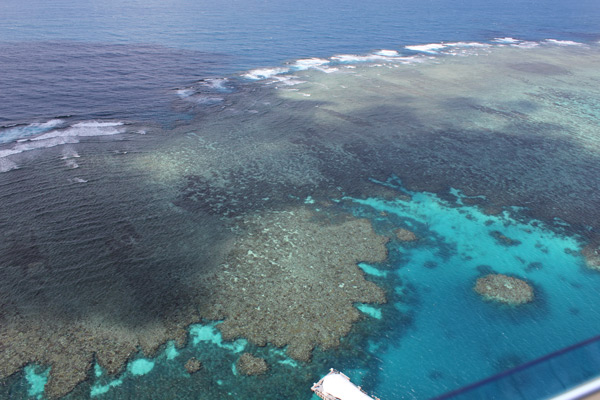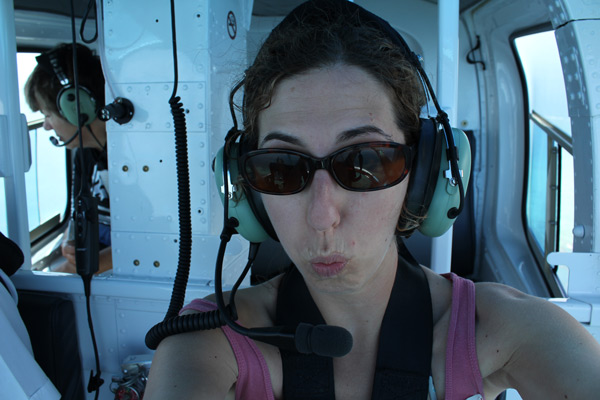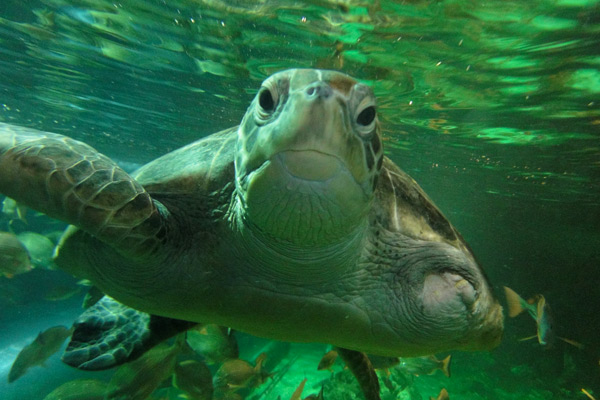Chris & Allyson vs. Australia (May 2012)
Day Seven: The Great Barrier Reef.
Ocean acidification is a scourge. It upsets the delicate underwater ecosystem, which in turn affects our atmosphere. That in turn threatens all life on Earth. On the seventh day of our Australian vacation, I contributed to it by puking in the ocean six times. I am so sorry.
This came to pass because we visited the Great Barrier Reef. If you go to Australia, you must visit the reef. When you return home, everyone will ask you if you saw the reef; it's the third question after "did you see a kangaroo" and "what's Paul Hogan like?"
And why wouldn't they be curious? The Outback is a steakhouse to most people, and the desert version has no blooming onions. No one will begrudge you the decision to skip it. The reef, on the other hand, is "Finding Nemo." It is one of our greatest natural treasures, according to numerous websites operated by reef tour companies. You are a horrible human being that wishes the death of every Pixar character -- even the old guy from "Up" -- if you do not spend at least $500 seeing it.
I liked "Up." I also enjoyed "Finding Nemo," though I regret telling Allyson that I almost cried while watching it because Nemo loves his dad. When you are sharing such information, it seems like a good-faith effort at emotional openness. In practice, it is an invitation for your wife to ask if you need a tissue any time you see a tropical fish.
The point is, we decided to see the Great Barrier Reef, and Cairns is a gateway to that magical place. We started day seven with breakfast amongst the Asians at the Pacific International, then walked the two magical blocks to the Cairns marina.

The Reef Magic!

Marine World's floating platform, on the Great Barrier Reef.

A shot of Marine World, from above.
We had booked our tour a little bit in advance. The reef covers 130,000 square miles, and there are 3,000 companies waiting to whisk you off to the natural experience of a lifetime -- so you want to do some research before deciding who gets your hard-earned koala bucks. The reef is also, shockingly, underwater -- so you'll want to decide exactly how to see it. In the months before our vacation, we debated whether scuba or snorkeling would be the best value.
Neither Allyson nor I is scuba certified, but there was the possibility of training before our vacation. This was mentioned in the recounting of our shark adventure, but it bears repeating. Scuba certification is a simple matter of taking a classroom course that eats up one whole weekend; then doing a series of dives with rented equipment in a freezing abandoned quarry in Virginia, probably with an instructor who always has chest hair poking out of his partially unzipped wetsuit. After that meager commitment of several hundred dollars and four days of your time -- and a few awkward moments declining invitations to your instructor's fondue night -- you earn the privilege of spending $1,200 to be flown to a more-exclusive portion of the reef and dive for a day. From that point on, you are certified to scuba anywhere in the world for the rest or your life, even if you never practice or study, because apparently scuba is like riding a bike. Only, instead of skinning your knee when you fail, you get the bends or drown.
The other option is to play it by ear, take a snorkeling tour, then pay the tour operator an extra $100 on-site to take you scuba diving, even though you have no experience.
We like to keep weekends free for fight club, so we opted against the scuba lessons. Instead, a few days before reaching Cairns, we signed up for the scuba tour with Reef Magic. They claimed to have a nice spot on the reef, they had sea turtles on their brochure, and their prices were competitive. Plus, you can easily insert the company name into "Strange Magic" by the Electric Light Orchestra, then sing that throughout the tour until your fellow tourists want to keelhaul you. Reef Magic will even transport you to the reef.
Which brings us to the problem with the Great Barrier Reef: it's not near Australia. If you'd like an example of a well-developed tourist system, look at Hawaii. The reefs are just a short swim from the beach. When you get tired of snorkeling there, you walk up to the nearest hotel and enjoy an adult beverage in the shade of a large family from the Midwest. For reasons no one has explained to my satisfaction, Australians put their reef way offshore. You have to take a high-speed ferry to get there.
This was stressful, because me and high-speed ferries have a history. Allyson's family was nice enough to take us on a cruise out of Miami a few earlier, and one of the stops was Cozumel. We decided to take an excursion to mainland Mexico, which meant riding a high-speed ferry right after breakfast over choppy seas. They did not tell us of the choppiness until it was time to get on the ferry. We took Dramamine as the boat was departing, but Dramamine doesn't work so good once it leaves your stomach at high velocity. I remember doubling over in my seat, while the ferry's TVs showed a Mexican blooper show, wherein a man in a gorilla suit jumped out and surprised people. It didn't lighten the mood. Neither did Allyson and her mother laughing at me.
Still haunted by that memory, we took our medicine well in advance. The Dramamine was digested when we boarded the Reef Magic II, a fine vessel which seats 200 people in the height of tourist season. Because it was the off season, the boat was half full -- it made for a more comfortable voyage, and it decreased the chances of waiting in line to puke.
The views of the coastline on the ride to the reef are exquisite, when you aren't looking straight up at the clouds and praying to divine providence to spare the breakfast sausage you ate that morning at the Australian-Brazilian BBQ joint in your Asian-friendly hotel. The views on the actual boat were less appealing. On board, it was mostly Asian tourists changing color while praying to their respective deities.
I can't speak for our Chinese friends, but my prayers were answered. One hundred vomit-free minutes after leaving Cairns we arrived at a natural wonder of the world. Or at least a small part of it. As we've already covered, the GBR is huge, so saying you "saw" the reef in a day is like saying you "have a doctorate in chemistry" because you read the ingredients on a pack of Splenda. The Cairns tour companies have their assigned areas of operations. Within its area, Reef Magic has Marine World, a platform anchored to the seafloor.
Think of it as a superstore for all your Great Barrier Reef needs. They have:
- A glass-bottomed boat. This was the first thing we tried, and it was fun -- you get a view of the coral formations and glances at the fishies. You also get to spend some quality time with the older tourists, whose depressing plan was to take a 100-minute boat ride, take a 10-minute cruise in the glass-bottomed boat, then sleep in a deck chair for four hours. Just when you get disheartened by the ravages of time, a pretty fishy will swim by.
- An underwater observation room. This has several large windows, so you can view both fish and the many people in the water having a better time than you are.
- A helicopter platform. There are a few helicopter companies in Cairns, and each day they fly out to the platforms owned by the tour companies. From there, they take tourists up to get aerial views of the GBR for about 10 minutes. I had an ear infection, sea sickness and memories of vomiting 12 times during a helicopter tour in Hawaii in the eighth grade -- fear of chundering was a recurring theme on day seven. But Allyson was still up for the experience. A small boat took her to the platform, where she and two other tourists boarded the Airwolf; Allyson sat in front, because my generous decision to step aside made her the tourist with no partner. The helicopter climbed, then circled a bit to give everyone a sense of the majesty of the reef. From above, it's a canvas of blue and blue-green and green-blue and grayish-blue green and greenish-gray blue. You can spot the platforms of the other tour companies, and wonder if their bluish-gray green patch is any better than your greenish-bluish-grayish area. The pilot at one point asked if she could do Allyson the favor of taking her picture with our camera. My wife, being a wise and god-fearing woman, said it would be better for all parties if the pilot focused on flying the helicopter. I picked me a winner.
- A snorkeling area. When you're seasick, going into the sea seems like a stupid idea. But logically, you have nothing to lose. Once you're on the reef, everything moves all the time -- the boat, the platform, the ocean. It can't get worse, so I decided to go snorkeling, and maybe it would inoculate me.
I started by renting a "sting suit" -- a thin jumpsuit that aesthetically covers your billowing rolls of fat, while also preventing sea creatures from poisoning you to death. You should understand that everything in Australia is poison. All the deadliest snakes live there, there are swarms of evil jellyfish that close the beaches for months at a time; kangaroos are coated with contact poison; and everyone on Tasmania has a large venom sac and can spit into your eyes from 60 feet. It wasn't the right time of year for poisonous sea creatures to be around Marine World, but then again, no one thought a stingray was going to be the animal that took out Steve Irwin. Suit up.
The hard part of snorkeling at Marine World is getting past the 30 people who will invariably spend all five hours within 10 feet of the platform where you enter the water. Beyond those people, there exists a wonderful world of corals. They have the coral that looks like giant brains. They have the coral that looks like a bush with no leaves. They have all the corals that look like human extremities ravaged by a variety of venereal diseases -- which is to say, all the other kinds of corals. Sometimes you're swimming above a 30-foot underwater canyon with coral on both sides; other times you're floating over a plateau with the coral an arm's length away.
And then there's the fishies! Sadly, I have no pictures to share. You can buy "waterproof" containers to take your expensive digital SLR camera in the water, but it takes a stronger stomach than mine to trust your personal electronics to a glorified plastic bag. But I can still remember the clown fish, angelfish, and parrotfish.
The parrotfish aren't the prettiest. They get their name not from their bright colors, but the beaky protrusions around their mouth. They need these protrusions, because they eat coral and poop sand. Remember that the next time you're romantically rolling around and impregnating someone on a Pacific beach. If you're far enough from the madding crowd, you can actually hear the noise when they gnaw on the reef. It's like an Old Country Buffet, underwater.
I also saw a sea turtle in its natural habitat. He looked grumpy.
But on to the excitement. First, the gun on the wall: Halfway through your stay at Marine World, the good people at Reef Magic put out a delightful lunch spread. This spread is based on a simple principle: People engaging in strenuous water-based activity need the energy that only oily meat lasagna can provide. To wash it down, you can have some low-grade salad with oily dressing. Eat it all. You're going to need your strength.
Now, we set events in motion: I had backed out on the helicopter ride, mostly because I am cheap. Allyson had backed out on snorkeling, mostly because she doesn't swim so well. This might seem surprising, as we had been scuba diving earlier in the week. But in all honesty, Allyson does not enjoy swimming, She moves with the gracefulness of a newborn deer finding its legs, that is then forced to take YMCA swimming lessons before finding them.
So we both had something to prove before leaving the Great Barrier Reef. The good people at Reef Magic had a proving ground in mind. "Adventure Snorkeling" takes you outside of the "reef wall" -- the high underwater ridge of coral at the edge of Reef Magic's territory, which helps break up the waves that otherwise roll through the Coral Sea. The water is deeper, the fish are bigger, and they travel in schools. The surf is rougher, but they told us that anyone who could successfully pay for Adventure Snorkeling would be just fine.
About 90 minutes after lunch, we boarded a tiny boat which took us and a few other intrepid snorkelers outside the wall. Then we hopped into the sea with our expert marine biologist guide, who was full of exciting information about the fish. Mind you, you couldn't see the fish, because the water was murkier outside the wall. So the "adventure" was hearing a lecture while bobbing up and down like a cork. You can simulate this at home by drinking a six pack, then telling your significant other that you're never emptying the dishwasher again.
Most of Adventure Snorkeling was ill-advised, as it turns out. Allyson quickly gave up on swimming, latching on to a life preserver dragged by our expert marine biologist. I gave up on my meat lasagna shortly afterward.
The sea swells were enough that the occasional wave would wash over your snorkel. This puts salt water in your mouth. Anyone ever stranded on a life raft or on a small island with a lone palm tree can tell you that drinking the ocean is a bad idea. I did not want to swallow, but it was an involuntary response. I got one solid mouthful of the Coral Sea, and I remember immediately thinking: Not good.
But there was an investment of money and pride at stake, so I soldiered on. I tried to keep up with the group as our marine biologist pointed out grayish blurs that were allegedly beautiful fish. I did see, quite clearly, a Chinese gentleman getting his introductory lesson with a scuba instructor; he looked grumpy. Then another wave swamped my snorkel. Then I swallowed. Then I remember immediately thinking: Here we go.
I have vomited many interesting places in my lifetime. Once, I took out most of a hostel bathroom in Key West. Once, I puked in a dumpster in a parking garage near the Library of Congress. Once, I puked on a high-speed ferry to Mexico, and in the Baltimore science museum, and in a helicopter over a Hawaiian rain forest. Before going to Australia, I had never puked in the ocean. In a testament to the broadening power of travel, I am here to tell you: The ocean is the absolute best place to vomit.
The usual vomiting experience is a horrid mixture of physical and psychological stress. Your muscles try to engage and release at the same time, your brain runs quick calculations of the gunner's formula and your heart starts writing apology letters to the people you're about to inconvenience.
The ocean simplifies everything. There is no stress about where to aim -- there's no way you can miss the ocean when you're in it. There is no anticipation of the horrifying sound -- just dip your mouth into the water, and no one can hear your shame. There is no tension in your body -- there's something about the soothing embrace of the ocean that lets you relax and let it flow. There is no need to fabricate an excuse for changing your shirt, because you won't have to change anything. You're already in the world's biggest Laundromat and group shower.
The only possible negative is the current. I was at the back of the group, and because god was smiling on me that day, the water carried the little bits of lasagna and salad away from my colleagues. My lunch was repurposed into fish food, and no one ever asked about my wellbeing or went into the breaststroke to get the hell away from me. Had the current been running the other way, it would have been a very long 90-minute boat ride back to the mainland. Instead, it was the perfect vomit, and I celebrated by vomiting five more times.
Somewhere around the fourth vomit, however, the novelty had worn off. It was a happy occasion to get back on the small boat and return to the terra infirma of Marine World. Allyson and I had enough time to clean up, compare notes and eat more Dramamine; then we had a very pleasant trip back to Cairns that involved a bare minimum of cold sweating.

The Great Barrier Reef from above.

Your trusted co-pilot.

Back on the ground.
I felt well enough to go jogging on our return, taking one more spin along the waterfront and heading back to the hotel at sunset. Flocks of birds were heading to their trees for the night, and running straight through them was like watching the stars streak as you went into warp. I don't run that fast, especially not after vomiting in the Coral Sea six times, so I'm aware it was an optical illusion. But it was a nice one.
We capped our exotic day with a domestic night. Dinner was at Cactus Jack's, an incredibly average Tex-Mex place near the cheap hotels. The most remarkable thing about it was that it was a Tex-Mex place in northeast Australia. We had ice cream from one of the local shops, then went to bed early.
And really, we had earned it. Already halfway around the world, we ventured off the coasts, braving the sun and the sea and the Asian tourists slowly turning green. We saw the Great Barrier Reef -- a glorious, remarkable gift from nature. Then we spent $700, and we puked on it.
You really should go.
